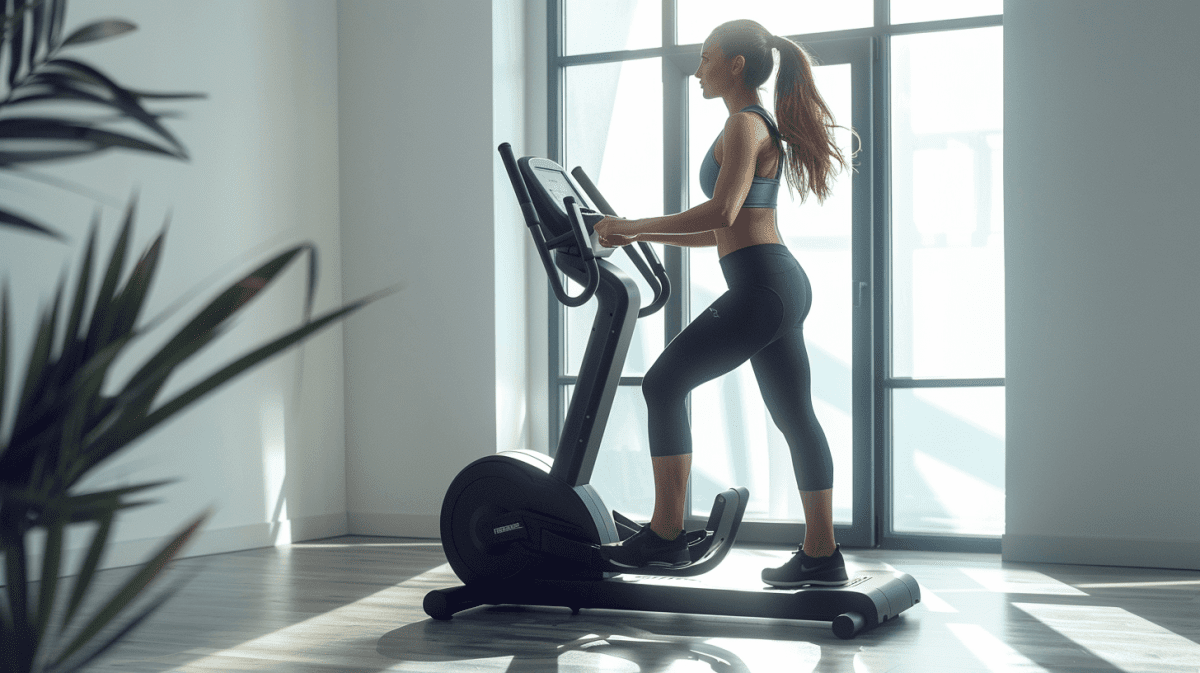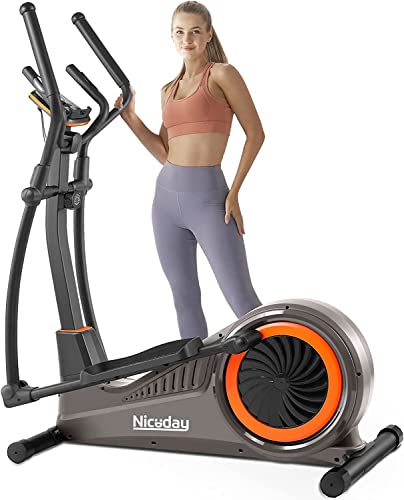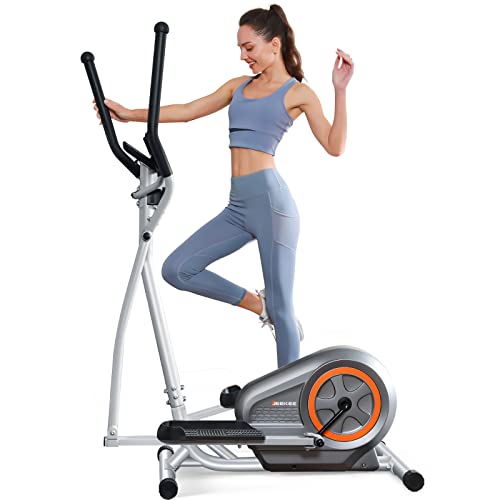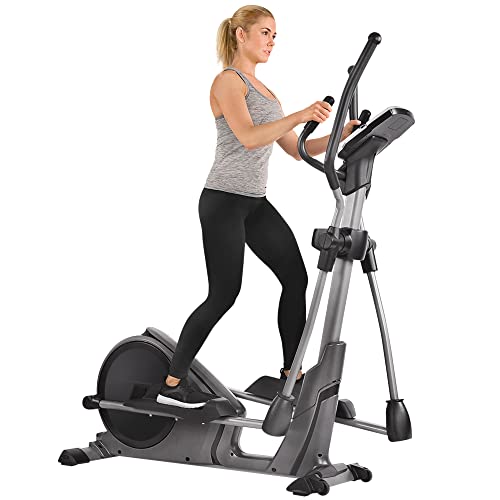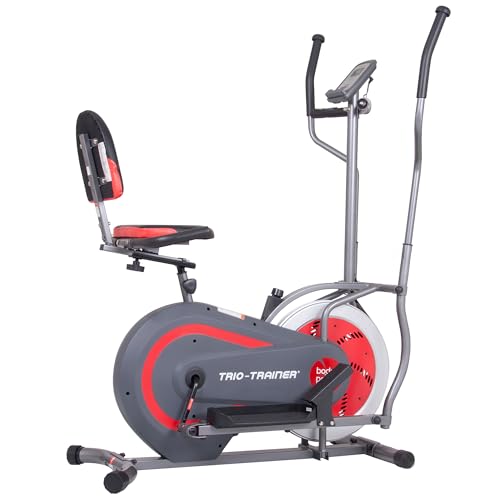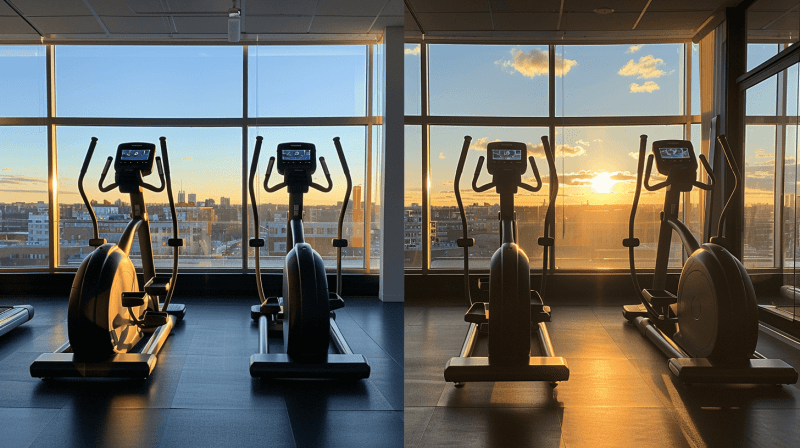You'll find that mastering the elliptical machine can transform your fitness routine into an efficient, joint-friendly workout experience. Whether you're new to exercise or a seasoned athlete, this versatile piece of equipment offers a customizable approach to cardio training while engaging multiple muscle groups simultaneously. While it might look straightforward, there's more to effective elliptical training than simply stepping on and starting to move. By understanding the proper techniques, workout strategies, and progression methods, you'll be able to maximize your results and avoid common pitfalls that many gym-goers encounter.
Key Takeaways
-
Begin with a 5-10 minute warm-up at low resistance, then gradually increase intensity to reach your target heart rate.
-
Maintain proper posture by keeping shoulders back, distributing weight evenly across feet, and holding handles with a light grip.
-
Alternate between forward and backward pedaling to target different muscle groups and prevent workout monotony.
-
Include 2-minute high-intensity intervals followed by 1-minute recovery periods for effective cardio training.
-
Progress gradually by increasing duration, resistance, and incline over time while monitoring your heart rate throughout sessions.
Understanding Elliptical Machine Benefits
Many fitness enthusiasts choose elliptical machines for their versatile workout benefits and joint-friendly design. As you exercise on an elliptical, you'll find that your body can maintain a steady, low-impact movement pattern while still getting an effective cardiovascular workout, making it an excellent choice for all fitness levels.
The elliptical machine offers a unique combination of benefits that'll help you make significant progress in your fitness journey. You can Keep your heart rate elevated throughout your workout while the machine's design protects your lower body joints, as your feet never leave the pedals. This gentle yet effective exercise approach allows you to build endurance without putting excessive stress on your knees, ankles, and hips.
What makes the elliptical particularly valuable is its adaptability to different fitness levels through adjustable resistance settings. As your strength and stamina improve, you can gradually increase the intensity of your workouts, ensuring continuous progress. Whether you're just starting your fitness journey or you're an experienced exerciser, the machine provides the flexibility to create challenging, customized workouts that match your current abilities and goals. The ability to pedal both forward and backward engages different muscle groups, allowing you to target your calves and hamstrings more effectively during your workout sessions.
Setting Up Your Workout
Getting started on an elliptical requires proper setup to maximize your workout's effectiveness. Before you begin training, adjust the resistance and incline settings to match your fitness level and target specific muscle groups, ensuring you'll get the most benefit from your session.
To properly use the elliptical and create an effective workout routine, follow these key steps:
- Start with a 5-10 minute warm-up at low resistance and moderate pace, allowing your body to prepare for more intense exercise
- Select either a pre-programmed workout or design your own interval training routine to vary intensity throughout the session
- Monitor your heart rate consistently to stay within your target zone, adjusting resistance and speed as needed
- Progress gradually by increasing both duration and intensity over time to build endurance
As you become more comfortable with the machine, you'll want to experiment with different combinations of resistance and incline levels. This variation helps target different muscle groups while preventing workout plateaus. Remember to maintain proper form throughout your session, and don't hesitate to adjust the settings if you find the current level too challenging or too easy. The low-impact motion of the elliptical makes it an excellent alternative to running while still providing effective cardiovascular exercise.
Proper Form and Technique
After setting up your workout parameters, mastering proper form reveals the full potential of your elliptical training. Your limb joint angular position plays a critical role in preventing strain and maximizing muscle activity during elliptical exercise. Keep your shoulders pulled back and down while maintaining an upright posture throughout your session to guarantee proper alignment and reduce the risk of injury.
When using the elliptical trainer, focus on distributing your weight evenly across your entire foot to minimize joint stress and enhance workout effectiveness. Grasp the moving handles to engage in a full body workout, allowing your arms to move naturally with the machine's rhythm. This coordinated movement pattern optimizes muscle engagement and increases calorie burn during your elliptical exercise in healthy ways.
To maximize results, incorporate both forward motion and backward pedaling into your routine. This variation targets different muscle groups while maintaining challenge throughout your workout. As you progress, gradually increase the resistance level to build endurance and intensify muscle activation. Remember that proper angular position and muscle engagement are key to achieving the best results while preventing unnecessary strain. Maintain a light grip on handlebars to ensure your legs are doing the primary work during the exercise.
Building an Effective Training Program
Success on the elliptical machine depends on following a well-structured training program that aligns with your fitness goals. Before you begin, make sure to CONSULT A PHYSICIAN, especially if it's the first time you try this form of exercise. Elliptical trainers offer a versatile workout that can accommodate various fitness levels while minimizing Lower limb joint angular stress. Full-body workouts on ellipticals help maximize calorie burn while toning multiple muscle groups simultaneously.
For a beginner elliptical workout, structure your program using these key components:
- Start with 5-10 minutes of warm-up at low resistance to prepare your muscles for activity during elliptical exercise
- Gradually increase your intensity to 60-70% of your maximum heart rate for sustained cardio benefits
- Incorporate 2-minute high-intensity intervals followed by 1-minute recovery periods
- Cool down for 5 minutes at decreased resistance to prevent muscle soreness
When you use the elliptical machine regularly, vary your routine by adjusting resistance levels and incorporating both forward and backward pedaling motions. Allow at least one day of rest between intense sessions to prevent overtraining. As you progress, you can increase workout duration and intensity while maintaining proper form throughout each session.
Intensity and Resistance Management
Managing intensity and resistance effectively on the elliptical machine builds upon your established training program. When you use the elliptical trainer, you'll need to progressively increase the resistance throughout your cardio workout to maximize calorie burn and build muscle. Start at a steady pace with moderate resistance, then gradually adjust the intensity until it's challenging to maintain a conversation.
To create a full-body workout, combine resistance adjustments with changes in incline. You'll want to increase the incline periodically while maintaining proper form, which engages different muscle groups and prevents your body from adapting to the exercise. During high-intensity intervals, push yourself with higher resistance levels to enhance muscle engagement and calorie expenditure.
Proper pedaling speed helps maintain optimal control and muscle engagement throughout your workout. As you approach the end of your low-impact workout, gradually decrease the resistance to allow your body to shift into a proper cool-down phase. This approach to Elliptical Training guarantees you're constantly challenging your muscles while sustaining exercise efficiency. Remember to vary your resistance patterns across workouts to prevent plateaus and maintain the effectiveness of your training sessions, always adjusting the intensity based on your fitness level and goals.
Progression and Workout Variations
Consistent progression and varied workouts are essential for maximizing your elliptical training results. Expert advice suggests that you shouldn't settle for the same routine day after day, as your body needs new challenges to achieve your fitness goals. With proper workout progression and strategic variations, you'll continue to see improvements in your endurance and strength.
Gradually increase your session duration by 2-3 minutes each week, while slowly raising the resistance level to guarantee your cardiovascular system is challenged.
Incorporate interval training by alternating between 1-minute high-intensity bursts and 2-minute recovery periods.
Target different muscle groups by switching between forward and backward pedaling every 5 minutes.
Experiment with incline adjustments throughout your workout to simulate various terrain types.
You can further diversify your routine by alternating between pre-programmed workouts and manual settings. When creating your own workouts, focus on incorporating different resistance levels and speeds to keep your body guessing and prevent workout plateaus. This approach confirms continuous improvement and maintains engagement in your fitness journey.
For beginners, steady-state cardio workouts can help build the foundational fitness needed to maintain a consistent pace for up to 30 minutes.
Safety and Injury Prevention
Injury prevention protocols should be your top priority when using an elliptical machine. Research shows that while ellipticals provide less stress and impact on the joints than running, proper technique remains essential for avoiding injuries. Before you start your workout, consult with a healthcare provider, especially if you have pre-existing conditions or injuries, as our Wellness Picks and Advice can't substitute for professional medical guidance.
To protect your body during elliptical training, maintain good posture throughout your session. Keep your back straight, shoulders relaxed, and core engaged while holding the handles with a light grip. Fit uses only high-quality equipment guidelines that recommend starting with 10-minute sessions and gradually increasing duration as your fitness improves.
Remember to incorporate adequate warm-up and cool-down periods into every workout session. The facts within our articles emphasize the importance of rest days between workouts to prevent overuse injuries and allow proper recovery. If you experience unusual pain or discomfort, stop exercising immediately and seek professional medical advice, as pushing through pain can lead to serious injuries.
Frequently Asked Questions
How Do You Train on an Elliptical?
You'll want to maintain proper posture, adjust resistance and incline levels, and mix in intervals. Keep your heart rate up, vary your stride length, and track progress for an efficient cross-training workout.
How Many Minutes on Elliptical Is a Good Workout?
Like a steady rhythm in your favorite song, you'll want to aim for 30 minutes of moderate-intensity elliptical training. You can start with 20 minutes if you're a beginner, extending up to 60 minutes as you progress.
Can You Get in Shape Just Using an Elliptical?
Yes, you can get in shape using just an elliptical through low-impact workouts that boost cardiovascular endurance. However, you'll see better results by combining it with strength training and monitoring your target heart rate.
Is 30 Minutes a Day on the Elliptical Enough to Lose Weight?
You'll lose weight with 30-minute daily elliptical workouts if you maintain proper intensity, resistance, and calorie deficit. However, you'll see better results by gradually increasing duration and combining it with a balanced diet.
Conclusion
Like a well-oiled machine, your elliptical training journey will run smoothly if you follow these essential guidelines. You'll maximize results by maintaining proper form, gradually increasing intensity, and varying your workouts to prevent plateaus. Remember to listen to your body, monitor your heart rate, and stay consistent with your training plan. With dedicated practice, you'll develop strength, endurance, and confidence while protecting your joints through low-impact exercise.
